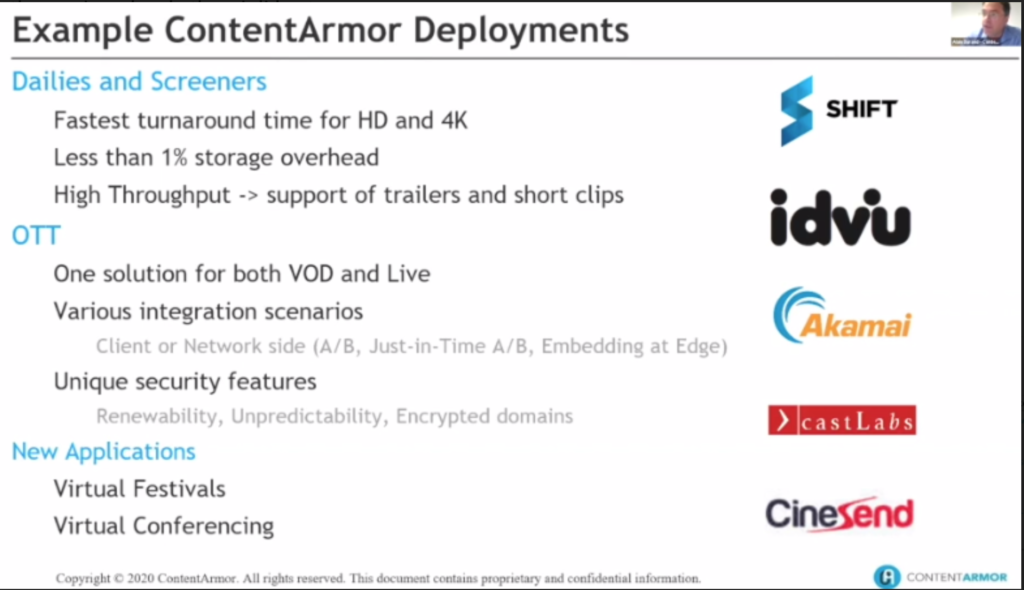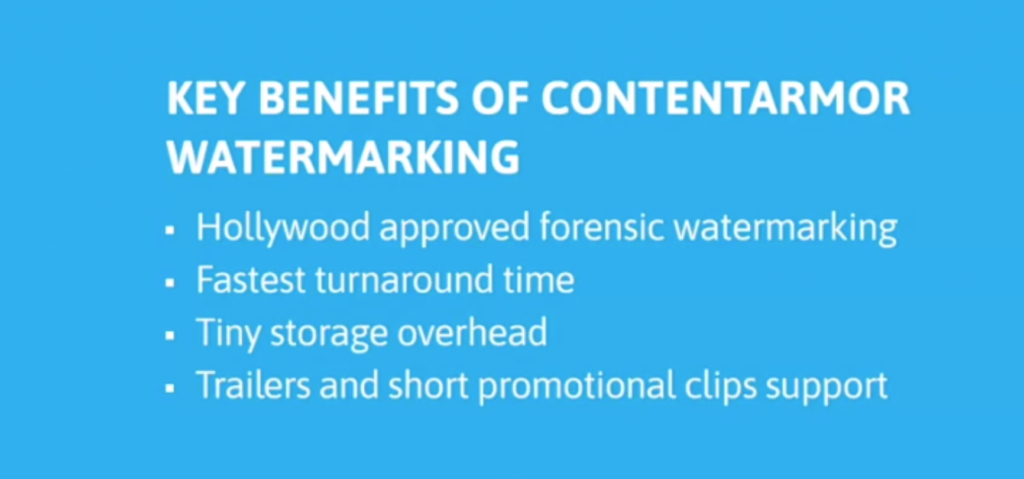M+E Daily

ContentArmor CEO: New Use Cases Require New Forensic Watermarking
Story Highlights
Since the start of the COVID-19 pandemic, we have seen growing demand for premium video on demand (PVOD) and the rise of new types of virtual video content and, with it, there is a need for new forensic watermarking to protect that content, according to Alain Durand, CEO of watermarking technology vendor ContentArmor.
ContentArmor’s bitstream forensic video watermarking technology can deter piracy for various use cases, including those new ones and comes at a time when the need to safeguard exclusive content has exponentially increased, he said Oct. 20 during the online Media & Entertainment Day event.
“Just as a reminder, watermarking is a technology that enables you to fight piracy by tracking back the source” of unauthorized users of content, he pointed out during the Threat Vectors & Monitoring breakout session“Watermarking Makes its Mark.”
“Watermarking has been around for almost two decades now,” he noted and pointed to six factors to use in picking a Forensic Watermarking Solution:
- Fidelity: the embedded watermark shall be invisible
- Robustness: the embedded watermark shall survive various operations performed by pirates including camcording and screencasting. “The mark will still be there” regardless.
- Security: the embedded watermark shall survive targeted attacks
- Throughput: the embedded watermark shall encode/detect information as fast as possible
- Resources: How much resources are needed? For example, “if you need two days to watermark one minute content, you might have very good technology, but it is very inefficient and is very useless.”
- Integration: How much modification to existing deployed systems is needed?
 He went on to point out the key applications, strengths and weaknesses for forensic watermarking that has typically been used for movies and live content.
He went on to point out the key applications, strengths and weaknesses for forensic watermarking that has typically been used for movies and live content.
“Mainstream” Forensic Watermarking for Movies
Main Applications:
Dailies and screeners
Focus on Deterrence
Strengths:
Fidelity and robustness first to get Hollywood approval
Security (anti collusion, etc.)
Limitations:
Need to deal with raw content
(ingest time, 4K support, etc.)
Forensic Watermarking for Live Content
Main Applications:
Sports protection is the main target
Block illegal retransmission in minutes
 Strengths:
Strengths:
Designed for easy client integration
High Throughput
Limitations:
Fidelity is often poor
Software-based security mainly
With the pandemic, “we are seeing two new applications appearing,” he went on to say. The first one is PVOD and the second is virtual festival content, he noted, pointing to the specific types of content that includes and the specific watermarking needs they have.
Changes Brought by COVID-19
PVOD extension:
More and more day and date releases on over-the-top (OTT) streaming services
Distributed on the same OTT platforms as sports
Virtual Festivals:
Mix of live talks and movies
New need for a unique watermarking solution tackling both VOD and live:
Hollywood-approved for robustness and fidelity
Secure implementation
High throughput and low complexity
Flexibility of integration
 And that is where ContentArmor’s bitstream watermarking comes in, he said. With it, the watermark payload is inserted directly on compressed videos and there is no need to decompress, so it has lower complexity, and it’s a software-only solution, so it offers flexible integration, he explained.
And that is where ContentArmor’s bitstream watermarking comes in, he said. With it, the watermark payload is inserted directly on compressed videos and there is no need to decompress, so it has lower complexity, and it’s a software-only solution, so it offers flexible integration, he explained.
It’s a solution that has been tested and approved already by Hollywood studios thanks to its: high robustness, high fidelity, unique security features (very easy to renew, unpredictability by changing the way it inserts watermarks, and can even add it to encrypted content), and high throughput.
Examples of ContentArmor deployments include: Dailies and screeners (because it offers the fastest turnaround time for HD and 4K, requires less than 1% storage overhead, and high throughput supporting trailers and short clips); OTT (because it offers one solution for both VOD and live, there are various integration scenarios, and its unique security features); and new applications (virtual festivals and virtual conferencing), he said.
In conclusion, the key benefits of ContentArmor watermarking are that it’s: Hollywood-approved forensic watermarking; it offers the fastest turnaround time; there is tiny storage overhead; and it supports trailers and short promotional clips, according to the company.
Click here to access the full presentation.
M&E Day was sponsored by IBM Security, Microsoft Azure, SHIFT, Akamai, Cartesian, Chesapeake Systems, ContentArmor, Convergent Risks, Deluxe, Digital Nirvana, edgescan, EIDR, PK, Richey May Technology Solutions, STEGA, Synamedia and Signiant and was produced by MESA, in cooperation with NAB Show New York, and in association with the Content Delivery & Security Association (CDSA) and the Hollywood IT Society (HITS).









